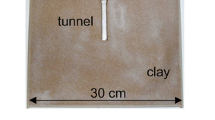Summary.
A key adaptation of obligate plant-ants inhabiting tropical myrmecophytes is the capacity to chew entrance holes into domatium walls. Our study of the factors determining ant entrance hole location in the ant-plant genus Macaranga (Euphorbiaceae) revealed a complex pattern caused by adaptations of both the host plants and their ant partners.¶1. Many adult Macaranga ant-plants possess "prostomata", i.e. preformed, thin zones of the stem, where ants preferably chew their entrance holes. The prostoma has the form of a straight line running the entire length of the internode. In all species except M. kingii it is located above the leaf insertion. Histological examination showed that the prostoma is characterized by the absence of vascular bundles and latex vessels and by a delayed cambium formation.¶2. Crematogaster ant workers recognize the position of the prostoma from inside the domatia by using incident daylight as an orientation cue. Experimental darkening of the translucent prostoma forced the ants to change over to other positions. We were able to make the ants chew holes at predicted, unnatural positions.¶3. When ants enter the domatia from outside, they are unable to find the prostoma. As a rule, holes in prostoma position were chewed from inside.¶4. Many Macaranga ant-plants lack a prostoma. The ant inhabitants of these species chew holes from outside the stem, exclusively on the twig undersides and at positions that are not related to phyllotaxy. However, colonies of these ants transplanted to "prostoma" hosts were nevertheless capable of chewing from inside the stem at "correct" prostoma positions.¶5. The stems of most prostoma-free Macaranga hosts are covered by slippery epicuticular wax crystals and their domatium walls are mostly thinner than in non-glaucous hosts. These correlations suggest that the prostoma acts as an ecological filter favoring specialists over generalists.
Similar content being viewed by others
Author information
Authors and Affiliations
Additional information
Received 6 September 2000; revised 27 February 2001; accepted 13 March 2001
Rights and permissions
About this article
Cite this article
Federle, W., Fiala, B., Zizka, G. et al. Incident daylight as orientation cue for hole-boring ants: prostomata in Macaranga ant-plants. Insectes soc. 48, 165–177 (2001). https://doi.org/10.1007/PL00001761
Issue Date:
DOI: https://doi.org/10.1007/PL00001761




